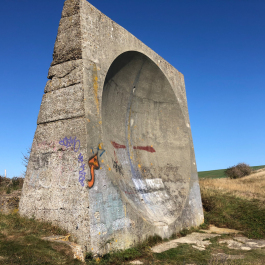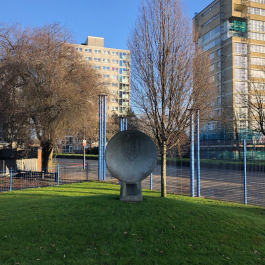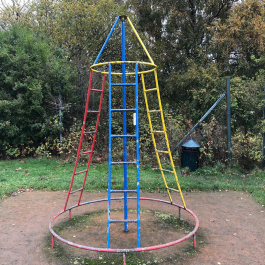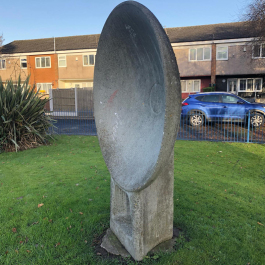
Sound mirror, Abbot’s Cliff, Dover, Kent
Standing several feet high in coastal or clifftop settings, and resembling giant concrete satellite dishes in their concave form, sound mirrors have become a cult icon of 20th century history and design, capturing the popular imagination both through their (retro)futuristic appearance and their association with redundant technologies. Originally developed as experimental early warning systems in the years between the two world wars, acoustic mirrors were designed to detect the sound of enemy aircraft before they became visible or audible to the human eye or ear by reflecting and focusing the sound of engines using a parabolic curve. In this, they can be seen as a short-lived pre-cursor to radar, which works by sending out radio waves to detect objects.
Today, remnants of this obsolete technology, which was always somewhat limited in its application, can be found up and down the east coast of England, from Kent to North Yorkshire. Usually found in remote and isolated locations, where they are slowly crumbling into the surrounding landscape, the best-known sound mirrors are probably those at Denge near Dungeness, where their inaccessibility – they are marooned in water and accessible by bridge only a few times a year – only adds to their allure, as does their association with a sparse, poetic shingle desertscape that has inspired artists from Derek Jarman to Tacita Dean.

Play sound mirror, Collyhurst, north Manchester
A busy, noisy arterial road heading out of Manchester city centre road to the north might seem like an unlikely spot, then, for a sound mirror, but an inner-city children’s playground in Collyhurst has also embraced the concept. Two, small replica concrete ears stand at either end of St Georges Community Grounds (now known as The Brian Kidd Recreational Facility in honour of the Manchester City footballer and coach Brian Kidd, who grew up in the area), a small, enclosed park facing directly onto the constant stream of traffic that is Oldham Road.
Although the links between Collyhurst and coastal sound mirrors might seem tenuous, they reflect a long history of technological experimentation in Manchester and the surrounding areas, from aviation to astronomy to warfare – developments which were often deeply intertwined and mutually dependent.
A stone’s throw away from the present-day site of St Georges Community Grounds, at Brownsfield Mill in Ancoats, the company AV Roe & Co (or Avro) was a pioneer of early aircraft (this heritage is now being used to sell loft apartments in the mill, as part of Urban Splash’s Avro development). The company designed and built aircraft that were used in both world wars and the first non-stop transatlantic flight, as well as the Shackleton, a maritime patrol aircraft that was used by the Royal Air Force during the Cold War and the Vulcan, which was developed as a nuclear deterrent capable of carrying nuclear weapons.
The physicist Bernard Lovell, meanwhile, was experimenting with radar during the Second World War at the Telecommunications Research Establishment. His findings helped the Royal Airforce to detect enemy targets at night and in bad weather and increase the accuracy with which they were able to drop bombs; radio systems developed by Lovell’s team were fitted to Avro’s Vulcan bombers. Other radar systems were developed by local firms Ferranti and Marconi, with another major Manchester company, Metropolitan Vickers, manufacturing transmitters (Ferranti’s Oldham site – subsequently in Israeli ownership – shut down in 2022, following prolonged protests over its manufacturing of surveillance weapons such as drones to be used in Gaza).
When Lovell joined the University of Manchester after the war, he realised the need for a site away from the city due interference such as electric trams. This led to the establishment of the Jodrell Bank Experimental Station at the university’s botanical gardens among the flat Cheshire plain, where Lovell’s team converted former army equipment that had become surplus to requirements into equipment to study meteors, thus pioneering the field of radio astronomy.
Today, Jodrell Bank is best known for its huge, rotating Mark 1 Lovell telescope, which towers over the countryside and is visible for miles around. Started in 1952, but not finished until 1957, its completion was delayed due to technological and budgetary changes, before its completion was finally expedited by its use in tracking the intercontinental Soviet missile Sputnik.
Jodrell Bank continued to play an important part in the space race and in disseminating popular mages of space travel, from the first images of the surface of the moon in 1966 to the sounds of the Apollo 11 astronauts walking on the moon in 1969. It also acted as an early warning defence system during the Cuban Missile Crisis. The Lovell Mark 1 remains a space age landmark today, as well as a working telescope that continues to expand our understanding of space. Now a popular science attraction and day out, Jodrell Bank also hosts a replica acoustic mirror or whispering dish, with which visitors can interact to explore the precedents for today’s more sophisticated technology.

Rocket climbing frame, Walsden, West Yorkshire
The space race didn’t just advance developments in science, but permeated all aspects of popular culture and everyday life in the second half of the twentieth century. Children’s play was no exception. Post-war children across Britain (other countries, too, had their own variations) were enlisted into the Cold War space race through opportunities for play and exploration. Children were challenged to ascend towards the sky, as high as they dared, on brightly coloured climbing frames resembling the shape of rockets or moon probes in outline, or hurtle through space on slides descending from rockets, while the streamlined nosecone of another popular piece of equipment, the rocking rocket, gently propelled children through the air. Despite their ubiquity at the time, few of these mass-produced pieces of Atomic era play equipment survive today, having fallen victim to wear and tear, health and safety – or just changing ideas about the nature and purpose of play.
The use of sound mirrors in play and popular science education today may speak to these changing priorities. Rather than celebrating the values of speed and competition, they require interaction, communication and collaboration. One person is invited to stand at each mirror and, as one speaks, the other is asked to listen. Like the century-old technology that inspired them, the effectiveness of these objects in transmitting sound is somewhat doubtful (particularly in busy urban environments) yet they encourage the user to stand still, to stop and to listen – skills which feel more pertinent than ever as once again East battles West and nations, citizens and entire continents are divided over ambitions for territory, control and expansion.

Play sound mirror, Collyhurst, north Manchester
Originally commissioned by Shock City, Spring 2023

Sound mirror, Abbot’s Cliff, Dover, Kent
Standing several feet high in coastal or clifftop settings, and resembling giant concrete satellite dishes in their concave form, sound mirrors have become a cult icon of 20th century history and design, capturing the popular imagination both through their (retro)futuristic appearance and their association with redundant technologies. Originally developed as experimental early warning systems in the years between the two world wars, acoustic mirrors were designed to detect the sound of enemy aircraft before they became visible or audible to the human eye or ear by reflecting and focusing the sound of engines using a parabolic curve. In this, they can be seen as a short-lived pre-cursor to radar, which works by sending out radio waves to detect objects.
Today, remnants of this obsolete technology, which was always somewhat limited in its application, can be found up and down the east coast of England, from Kent to North Yorkshire. Usually found in remote and isolated locations, where they are slowly crumbling into the surrounding landscape, the best-known sound mirrors are probably those at Denge near Dungeness, where their inaccessibility – they are marooned in water and accessible by bridge only a few times a year – only adds to their allure, as does their association with a sparse, poetic shingle desertscape that has inspired artists from Derek Jarman to Tacita Dean.

Play sound mirror, Collyhurst, north Manchester
A busy, noisy arterial road heading out of Manchester city centre road to the north might seem like an unlikely spot, then, for a sound mirror, but an inner-city children’s playground in Collyhurst has also embraced the concept. Two, small replica concrete ears stand at either end of St Georges Community Grounds (now known as The Brian Kidd Recreational Facility in honour of the Manchester City footballer and coach Brian Kidd, who grew up in the area), a small, enclosed park facing directly onto the constant stream of traffic that is Oldham Road.
Although the links between Collyhurst and coastal sound mirrors might seem tenuous, they reflect a long history of technological experimentation in Manchester and the surrounding areas, from aviation to astronomy to warfare – developments which were often deeply intertwined and mutually dependent.
A stone’s throw away from the present-day site of St Georges Community Grounds, at Brownsfield Mill in Ancoats, the company AV Roe & Co (or Avro) was a pioneer of early aircraft (this heritage is now being used to sell loft apartments in the mill, as part of Urban Splash’s Avro development). The company designed and built aircraft that were used in both world wars and the first non-stop transatlantic flight, as well as the Shackleton, a maritime patrol aircraft that was used by the Royal Air Force during the Cold War and the Vulcan, which was developed as a nuclear deterrent capable of carrying nuclear weapons.
The physicist Bernard Lovell, meanwhile, was experimenting with radar during the Second World War at the Telecommunications Research Establishment. His findings helped the Royal Airforce to detect enemy targets at night and in bad weather and increase the accuracy with which they were able to drop bombs; radio systems developed by Lovell’s team were fitted to Avro’s Vulcan bombers. Other radar systems were developed by local firms Ferranti and Marconi, with another major Manchester company, Metropolitan Vickers, manufacturing transmitters (Ferranti’s Oldham site – subsequently in Israeli ownership – shut down in 2022, following prolonged protests over its manufacturing of surveillance weapons such as drones to be used in Gaza).
When Lovell joined the University of Manchester after the war, he realised the need for a site away from the city due interference such as electric trams. This led to the establishment of the Jodrell Bank Experimental Station at the university’s botanical gardens among the flat Cheshire plain, where Lovell’s team converted former army equipment that had become surplus to requirements into equipment to study meteors, thus pioneering the field of radio astronomy.
Today, Jodrell Bank is best known for its huge, rotating Mark 1 Lovell telescope, which towers over the countryside and is visible for miles around. Started in 1952, but not finished until 1957, its completion was delayed due to technological and budgetary changes, before its completion was finally expedited by its use in tracking the intercontinental Soviet missile Sputnik.
Jodrell Bank continued to play an important part in the space race and in disseminating popular mages of space travel, from the first images of the surface of the moon in 1966 to the sounds of the Apollo 11 astronauts walking on the moon in 1969. It also acted as an early warning defence system during the Cuban Missile Crisis. The Lovell Mark 1 remains a space age landmark today, as well as a working telescope that continues to expand our understanding of space. Now a popular science attraction and day out, Jodrell Bank also hosts a replica acoustic mirror or whispering dish, with which visitors can interact to explore the precedents for today’s more sophisticated technology.

Rocket climbing frame, Walsden, West Yorkshire
The space race didn’t just advance developments in science, but permeated all aspects of popular culture and everyday life in the second half of the twentieth century. Children’s play was no exception. Post-war children across Britain (other countries, too, had their own variations) were enlisted into the Cold War space race through opportunities for play and exploration. Children were challenged to ascend towards the sky, as high as they dared, on brightly coloured climbing frames resembling the shape of rockets or moon probes in outline, or hurtle through space on slides descending from rockets, while the streamlined nosecone of another popular piece of equipment, the rocking rocket, gently propelled children through the air. Despite their ubiquity at the time, few of these mass-produced pieces of Atomic era play equipment survive today, having fallen victim to wear and tear, health and safety – or just changing ideas about the nature and purpose of play.
The use of sound mirrors in play and popular science education today may speak to these changing priorities. Rather than celebrating the values of speed and competition, they require interaction, communication and collaboration. One person is invited to stand at each mirror and, as one speaks, the other is asked to listen. Like the century-old technology that inspired them, the effectiveness of these objects in transmitting sound is somewhat doubtful (particularly in busy urban environments) yet they encourage the user to stand still, to stop and to listen – skills which feel more pertinent than ever as once again East battles West and nations, citizens and entire continents are divided over ambitions for territory, control and expansion.

Play sound mirror, Collyhurst, north Manchester
Originally commissioned by Shock City, Spring 2023
⬑
⬑